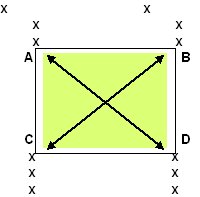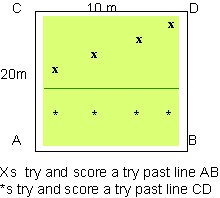COLLECTIVE SPORTS
UNIT: RUGBY
LESSON: 3/4
Aim:
PASSING SKILLS AND APPLICATION IN GAMES SITUATIONAPPARATUS: Rugby balls, cones/markers
ORGANISATION
CONTENT
TEACHING POINTS
Number of players:
Two teams of 4-5.
A designated play area may be marked with cones or markers. It has to have the goals at either end.
WARM UP: ball familiarisation, tackling
1- End Ball
There are two teams. The game starts by passing the ball in from the end-line.
Players move and pass the ball to their receiver at other team's end-line. This player can move anywhere along end line but not in front of it. Ball can be passed in any direction.
To stop a player moving with the ball, touch with two hands on his/her waist (i.e. a tag).
When a player is tagged, he/she has to stop and pass the ball to a team-mate and the game continues.
Changes to the game:
Easier: Make area wider and goals bigger. Make three goals. No interceptions.
In groups of 3 or 4. Groups line up at markers on the four corners of the grid.

One can set up 1, 2, 3 or more grids.
MAIN PART: skills; running with the ball
2- Run with the ball 1:
Each group has a ball which is carried by the first member of the group diagonally across the grid and handed to the next person in that group. Each ball carrier has to be encouraged to carry the ball in two hands (with fingers in line with the seams of the ball, not holding the ends of the ball).
So, nº1 at A runs diagonally across and hands the ball to nº2 at D, similarly nº1 at B runs across and hands the ball to nº2 at C. Similarly with groups C and D.
Then, the seconds of each group do the same. After the seconds, the thirds.
3- Run with the ball 2:
As above, but placing the ball on the ground as if scoring a try 1 metre in front of the marker instead of handing the ball over. The ball has to be placed on the ground with downward pressure – it should not be dropped or bounced.

Skills: passing under pressure
4- 2 v 1
Children are divided in groups of three. In each group, two are the ball carriers and the third one is the defender. The ball carriers have to pass the ball between them avoiding the defender, following the next instructions:
• ball held with fingers spread,
• player keeps running forwards,
• body twists at hips until shoulders face receiver,
• ball swung back at hip level,
• arms swing and release ball towards receiver,
• follow-through: hands end action pointing to receiver.
• Passing activity: Develop passing backwards – no forward or straight passes are allowed.
Children are in groups of three and have to practice backward passes. The child who carries the ball has to try to speed up before passing the ball and then, this child who has passed the ball should slow down – thus the ball carrier should be ahead of the person he/she passes to in order to pass the ball backwards.

GAME:
5 - 4 v 4
Two teams of four children each, one team plays against the other. Rules:
• Ball must be passed backwards,
• Tries are scored past the grid lines,
• Tackles are made by touching with two hands on the hips.
• If the ball is passed forwards or goes out of play – the other team restarts the play with a free pass.
It is important to encourage players to run forwards- it is easier for supporting players to be behind the ball.
Remember- if touched, the ball carrier must pass the ball within 1 second.